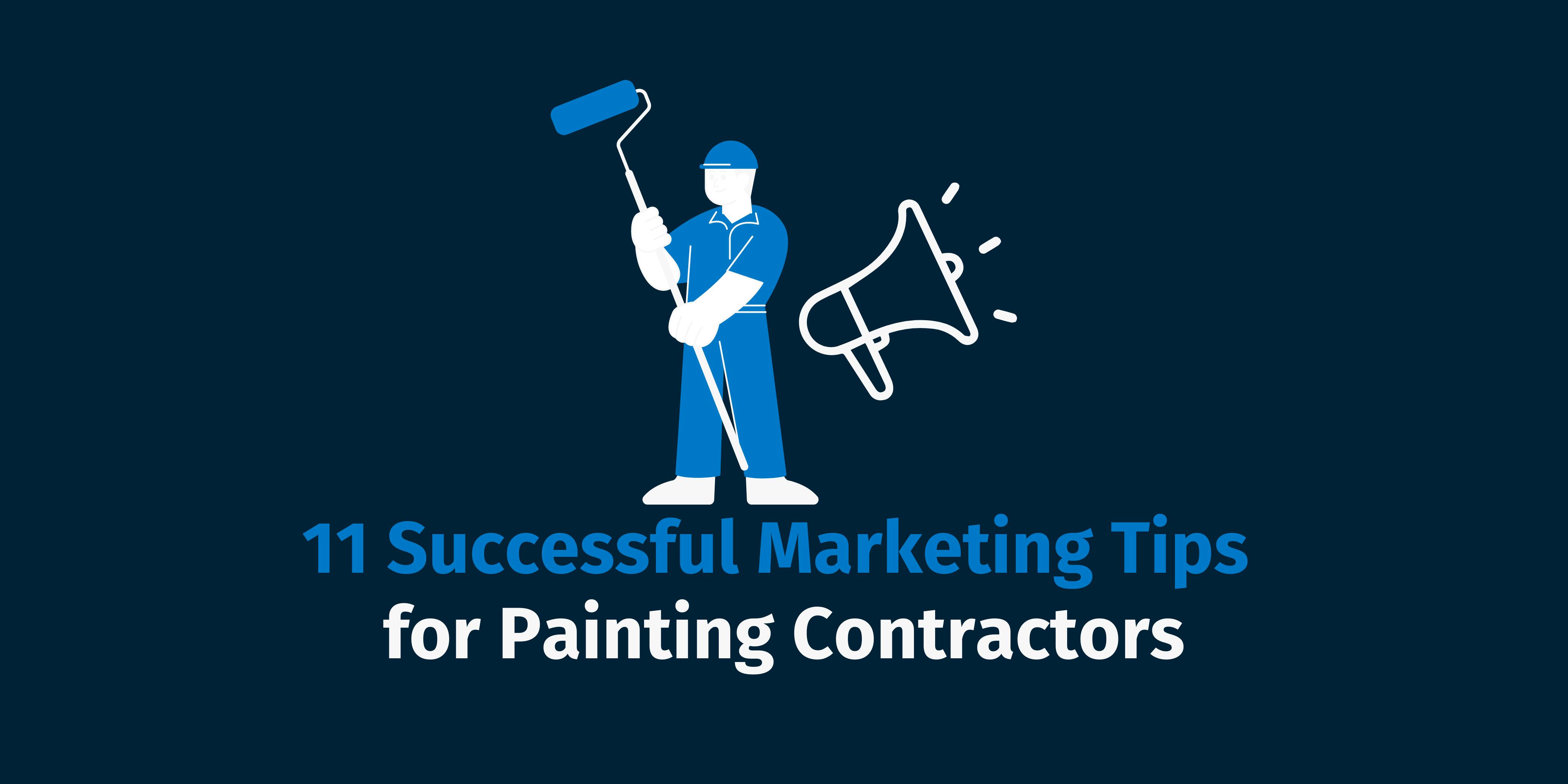It is not uncommon for trade workers to branch out on their own and establish their own businesses in their preferred trades. Unsurprisingly, many paint contractors follow the same path but wanting to and knowing how to start a painting business are two very different things.
In this post, you’ll find the basic information you need on how to start a painting company.
How to Start a Painting Company
Understanding the Painting Industry and Its Potential for Growth
The Coronavirus pandemic caused a lot of upheaval in all industries, including construction and trade. As the world managed to move through it, today’s economic outlook is volatile enough to make anyone pause before a career change. However, economic uncertainty may not be bad news for painting companies, depending on several factors.
Low Startup Costs = Low Risks
Startup costs for painting companies are relatively low compared to other industries. With a little bit of investment in basic equipment and materials, such as brushes, rollers, ladders, and paint, anyone can start a painting business from home or a small office. This low initial investment means a lower risk for entrepreneurs who are starting out and looking to enter the painting industry.
Healthy Profit Margins
Healthy profit margins make painting businesses look more attractive as well. Financial experts have said a 10 percent profit margin is considered average, 20 percent is good, and 5 percent is low in general. However, painting companies can earn profits of up to 30 to 40 percent on their projects, which is significantly higher, including construction with a 1.5% to 2% standard profit margin.
With the right pricing strategy and a good reputation for quality work, painting companies can generate a healthy income stream.
Positive Cash Flow
Painting businesses typically can generate income quickly after completing a job, unlike many other skilled construction trades, which equates to having a positive cash flow. This is because customers typically pay for services rendered soon after the work is completed, which gives you the cash flow needed to invest in the growth of your painting business. This positive cash flow also helps with financial planning and securing loans or financing for future projects.
Growing Market
As new buildings are constructed and older buildings are renovated, there is a continuous demand for painting services. Due to this, the painting industry is a growing market with additional opportunities for growth in the future.
Environmentally friendly and sustainable products and services are increasingly important in today’s global consumer market. Forward-thinking paint businesses offering eco-friendly paints, coatings, and other services will have even more opportunities in the future, to grow and thrive in the market. You can learn more about this in our Marketing Tips for Painting Contractors post.
Starting Your Own Painting Business: The Basic Checklist
While starting a painting company does not involve as much as more complex businesses, all new businesses have legal requirements. You will need to have a clear mission with realistic plans, accurate financial needs and projections, and how you will run your business, just to name a few. Here is a basic checklist to guide you.
1. Create a Business Plan
A business plan is a necessary part of having a successful business, regardless of company size, location, or industry. It serves you and those who work for your company by ensuring you are always heading in the right direction and as a continued reminder of your company goals, mission, and purpose.
Business plans can be tedious and challenging, but they are among the most important documents of any business. Usually 20 to 50 pages in length, your business plan clearly explains the strategies you will use to achieve the company goals you have designed.
Conduct Market Research
If you’ve been a professional painter in the area for years, you likely already know how to perform as a professional painter and understand the expectations of most customers. You’re also probably familiar with most local painting contractors and the surrounding service areas, too. But none of this is the same as market research because your previous experience in the industry may not be an accurate gauge of what you need to know, to create a profitable and sustainable painting business.
Research your intended service areas - as well as those surrounding them - to identify market needs. Are there any active commercial or industrial painting companies? Is the area saturated with interior painters but lacking exterior painting services? Consider any seasonal disruptions that might cause cash flow problems. What types of specialty painting services - if any - are lacking and what kinds of additional services/certifications can you get that might make your services more desirable?
Choose Your Specialty
There are three primary options to choose from when deciding what kind of painting services your company will provide:
- Commercial
- Residential
- Industrial
Among these three types, there are additional specialties such as interior, exterior, bridges, manufacturing plants, and office buildings - just to name a few - as well as different specialized techniques and styles like Venetian Plaster, Grit Coatings, or Powder coatings.
Decide on the Name
Starting a painting business will obviously require a name for the company, but there are important things to consider before finalizing the name of your operation.
It’s a good idea to include the word “painting” in the company name. This eliminates the possibility of confusion when someone is unsure of what your company does.
Be sure your company name is unique. Research competitors and other small businesses that serve the same areas you intend to, and ensure there are none that have names similar to yours. You can do this through the Secretary of State of your state by searching through the database for names of painting contractors in your area that sound or look like the name you’ve picked.
Decide on Business Structure
To be a legal entity and benefit from different tax breaks and credits, you’ll need to decide what type of business structure you’ll have. When you first start out, you might prefer to be a sole proprietor, but as your business grows, you will get more benefits by changing to the most common for small startups: LLCs and S Corporations
While both structures provide liability limits, each has pros and cons. It’s important to speak with a financial or business advisor, to help you make the best choice for your company and the future.
Determine Your Service Rates
Set your prices based on your market research and the costs of running your business. Make sure to factor in your overhead costs such as supplies, labor, and marketing expenses. Be sure to have realistic expectations and use accurate numbers to develop your service prices. You want to enjoy profits but you also want to remain competitive among other painting contractors.
Develop Financial Projections
Create a financial plan that outlines your startup and ongoing expenses, expected revenue, and profits. Be sure your figures are accurate and realistic, so your financial goals will be achievable.
Create a Service Agreement
A service agreement is a legal document that outlines the terms and conditions of your services. It should include details on pricing, payment terms, warranties, and liability, and you should make sure it leaves room for any special or unique aspects of a painting job.
2. Make It Legal
Once you have the basics achieved, it’s time to make your business a legal entity, available for new painting projects and jobs.
Register With the Secretary of State
After you’ve chosen your business structure and determined the name of your painting company, you’ll need to register with the Secretary of State. If you’ve decided to start as a sole proprietor or spousal partnership, you may not need to do this. In some states, you may need to register in the county or municipality where you’ll be providing services, and it’s your responsibility to make sure you’re compliant with business registration and other paperwork.
Here are the most common types of business structures:
- Limited Liability Company (LLC) - limits the personal liability of its owners, but allows the profits to be taxed on either a member level or the corporate level.
- Sole Proprietorship - one person is responsible for all a company’s profits and debts.
- Partnership - owned by two or more individuals, allowing the partners to share profits and losses.
Register With the IRS
When you register your painting company with the IRS, you will receive an Employer Identification Number (EIN) to file the necessary taxes for your company. Depending on your location, you may also need to register for state and local taxes.
3. Set Up a Business Bank Account
Even if you have a sole proprietorship and work predominantly by yourself, you will want to keep your personal and business finances separate. This will help you keep accurate records of your business expenses and income, which will make tax season easier.
4. Get the Right Licenses
You must have the necessary licenses to conduct business as a painting contractor.
Each state may have different requirements for licensing, and you may need additional licenses if you are working with hazardous materials of any kind. Research what’s required in your service area, and obtain the right licenses before your company opens for business.
5. Get Insurance
Even if you are protected from certain liability as a registered LLC or other company structure, insurance protects you and your business from further liability. Additionally, if you’re going to have employees, you’ll need to get worker’s compensation insurance to cover medical expenses and lost wages in the event of a work-related injury or illness.
Even if such an incident happened because your employees did not practice proper painting safety guidelines, without Worker’s Compensation insurance, your company would be responsible for the employee’s medical expenses and any other costs associated with it, out of pocket. This could be a devastating blow, so it’s worth staying safe with the right insurance to cover your business.
Here are the most common types of insurance for painting businesses:
- General Liability - protects against lawsuits or other financial liabilities that result from a wide range of accidents, like a fire caused by faulty work.
- Business Owners Policy - Extends general liability coverage to protect things like your commercial buildings and personal property.
- Worker’s Compensation - provides coverage for your employees who become ill or injured while on the job.
- Umbrella Policy - provides coverage for injuries, property damage, certain lawsuits, and personal liability situations.
6. Secure Any Necessary Funding
While painting companies require considerably less capital than other construction/trade SMEs, you may still need to obtain a small amount of funding for your startup costs. You need to be very realistic about the startup costs, so you don’t run out of cash before you even get started.
Once you have calculated your startup costs and examined your existing capital funds, additional places you can look for funding include:
- Traditional loans
- Online lenders
- Personal loans
- Self-funding
- Investors
- Crowdfunding
- Friends and family
Before trying to obtain funding, make sure you have a clear and professional outline of your company’s financial standing and accurate financial reports to illustrate your future financials, including a profit and loss statement
7. Invest in the Right Tools and Supplies
Even if you’ve been in the painting trade for years, and have stockpiles of painting tools, materials, and supplies, you should make sure you have fully functional, professional tools and supplies to begin working. The minimum you’ll need includes:
- Brushes, rollers, and trays
- Primer
- Sandpaper - different grits
- Drop cloths
- Sprayers
- Ladders
- Proper storage for chemicals and tools
- Painter’s tape
Often, local building material suppliers have contractor accounts available that give professional painters appreciable discounts on their purchases. Be sure to sign up for any such accounts like this.
8. Market and Sell Your Painting Services
The Academy for Professional Painting Contractors says the number one reason “rarely rich” is because they do not spend enough time on the business part of their companies. But starting a painting business is about far more than just being a professional painter. There are many other important aspects of running your business and keeping things on track. Marketing is one of the most important of these aspects, to start getting customers.
Build a Website
Building a website helps you establish an online presence and gives you a place to showcase your services to potential customers. Consider hiring a professional web designer or, if you want to try it yourself, there are a variety of website-building platforms like Wix or Squarespace.
Create Social Media Business Pages
Social media is a powerful marketing tool that puts your work in front of potential customers. Since painting is a highly visual trade, platforms like Facebook, Instagram, and Twitter are great for showing off your completed paint projects. You can also use social media to share valuable customer reviews and promote your business with occasional specials or coupons
Use Online Advertising
Online ads, such as Google AdWords or Facebook Ads, can help you reach a larger audience and drive traffic to your website. These types of online ads have different cost structures and are very reasonably priced to get ads for your painting company in front of those who need to see them.
Set Up Your Google Listing
Google My Business comes with the valuable opportunity to get your business listed - for free - with the world’s largest and most-used browser. This is particularly important for trades like painting because it increases your visibility in local search results, and gives users access to your contact information, photos, hours of operation, and more.
Community Involvement
Small, locally-owned businesses can become quickly recognized as valuable contributors to the community by sponsoring local events. Charity fundraisers, church events, city or town celebrations, etc. are great opportunities for you to establish connections with potential customers and build goodwill in your community.
Referrals and Discounts
All skilled tradespeople know word of mouth is one of their greatest sources of new customers. Make sure your existing customers know they will receive a discount for any referral of new customers to your business, as a thank-you for helping you grow your client base.
9. Grow Your Team
As your business grows, you will need to hire additional employees to keep up with demand. Make sure to follow all applicable labor laws and regulations and provide your employees with the necessary training and equipment to do their jobs safely and effectively.
Start a Painting Company With Confidence
Use this checklist on how to start a painting company to begin planning your shift to entrepreneur. With patience, dedication, and focus, you can start, almost immediately, to build your painting business. Be sure you are armed with the right tools and information to make smart decisions that increase your company’s chance of success.
Discover more tools that help painting contractors grow by reading our post about The 9 Best Software Tools for Painting Contractors in 2023.
FAQ
Is Painting a Profitable Business?
Yes, painting can be a profitable business if you have the necessary skills, tools, and marketing strategies to attract and retain customers.
How Much Does It Cost to Start a Painting Business?
The cost of starting a painting business varies based on factors such as your location, the size of your business, and the equipment and supplies you need. However, you can expect to spend anywhere from $2,000 up to as much as $7,000.
Do You Need a License to Start a Painting Business?
You will likely need a contractor's or home improvement license to legally operate a painting business and, if you’re working with certain chemicals or hazardous materials, you might need specific licenses or certifications to operate. Before starting your business, research the specific requirements in your area.
What Equipment Do I Need to Start a Painting Business?
To start a painting business, you will need some basic equipment, including paint brushes, rollers, sprayers, drop cloths, and ladders. You will also need a reliable vehicle to transport your equipment and supplies to job sites. In addition, you may need to invest in specialized equipment for certain types of painting jobs, such as scaffolding or pressure washers. It's important to research the specific equipment needs for your business and budget accordingly.
What Are the Most Common Mistakes to Avoid When Starting a Painting Business?
Starting a painting business can be challenging, but avoiding common mistakes can help you build a successful and profitable business. Some mistakes to avoid include:
- Underestimating the cost of materials and labor
- Failing to market your services effectively
- Not establishing clear contracts and payment terms with clients
- Failing to invest in ongoing training and education for yourself and your employees
- Neglecting the business side of owning your own company
- Mismanaging finances or not planning for seasonal fluctuations
- Not staying up-to-date with industry trends, customer needs, and technology updates












